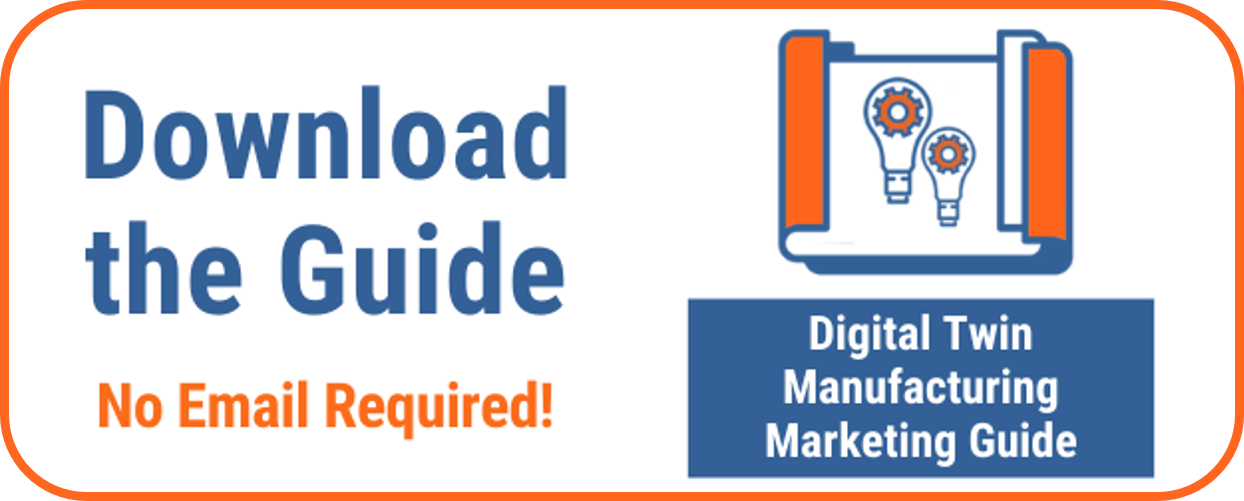Are you writing a blog post just for the fun of it? Heck no: You’re writing to create content that customers will love AND helps you stand out from the competition. Our blog post checklist ensures you’ll achieve both goals with every piece of blog content.
With each blog post you create, you’re also investing time, energy, and, of course, money. But you don’t want that investment squandered, especially when it’s the basis for your content marketing.
To help you maximize results, focus on these two crucial areas when creating a blog post:
1. Position yourself against the competition first. Differentiating your blog post and your content is something both your customers AND Google are looking for.
2. Include the following key elements every time. The purpose of the checklist is to ensure consistency. Use this approach every time you create a blog post to ensure quality and consistency.
We’ll show you how to do this through the following steps:
Build Your Strategy
Find Data and Insights to Include in Your Post
Create a Great Headline
Structure Your Content for Skimmers
Optimize the Post
Use an Effective Review Process
Promote Your Blog Post
Analyze the Results
Step 1: Build Your Strategy
You’re chomping at the bit to get started. But be warned: Without a strategy in place, you’ll find the writing tough sledding, and you likely won’t see results.
☐ Conduct persona research so you avoid a HUGE mistake
In his book Building a StoryBrand: Clarify Your Message So Customers Will Listen, Donald Miller sums up the biggest mistake content marketers make in creating a blog post.
The first mistake brands make is they fail to focus on the aspects of their offer that will help people survive and thrive.
If you are not writing on a topic that will help your customers survive or even thrive as a business, why would you expect them to read it? Would you read it? Absolutely not.
Build a persona and talk to your sales team to find out what topics truly matter to your customers. Miller’s formula for making your customer the hero of your marketing is an easy and effective way to generate customer-centric topics.
At the very least, we recommend conducting at least three one-on-one interviews with key customers and prospects, and then creating a persona based on their input. Be sure to interview your sales team for their invaluable insights and perspectives.
☐ Use keyword research to determine if there is search volume traffic
There are a number of different reasons you are creating a blog post — thought leadership, sales enablement, influencer interviews.
No matter what the reason may be, you should always conduct keyword research to determine if people are searching for a specific phrase associated with the topic.
A lightning-quick way to determine if there is search volume for keywords is to add the Keywords Everywhere extension to your chrome browser. Type in any keyphrase and you can instantly see estimates of keyword searches on a monthly basis.
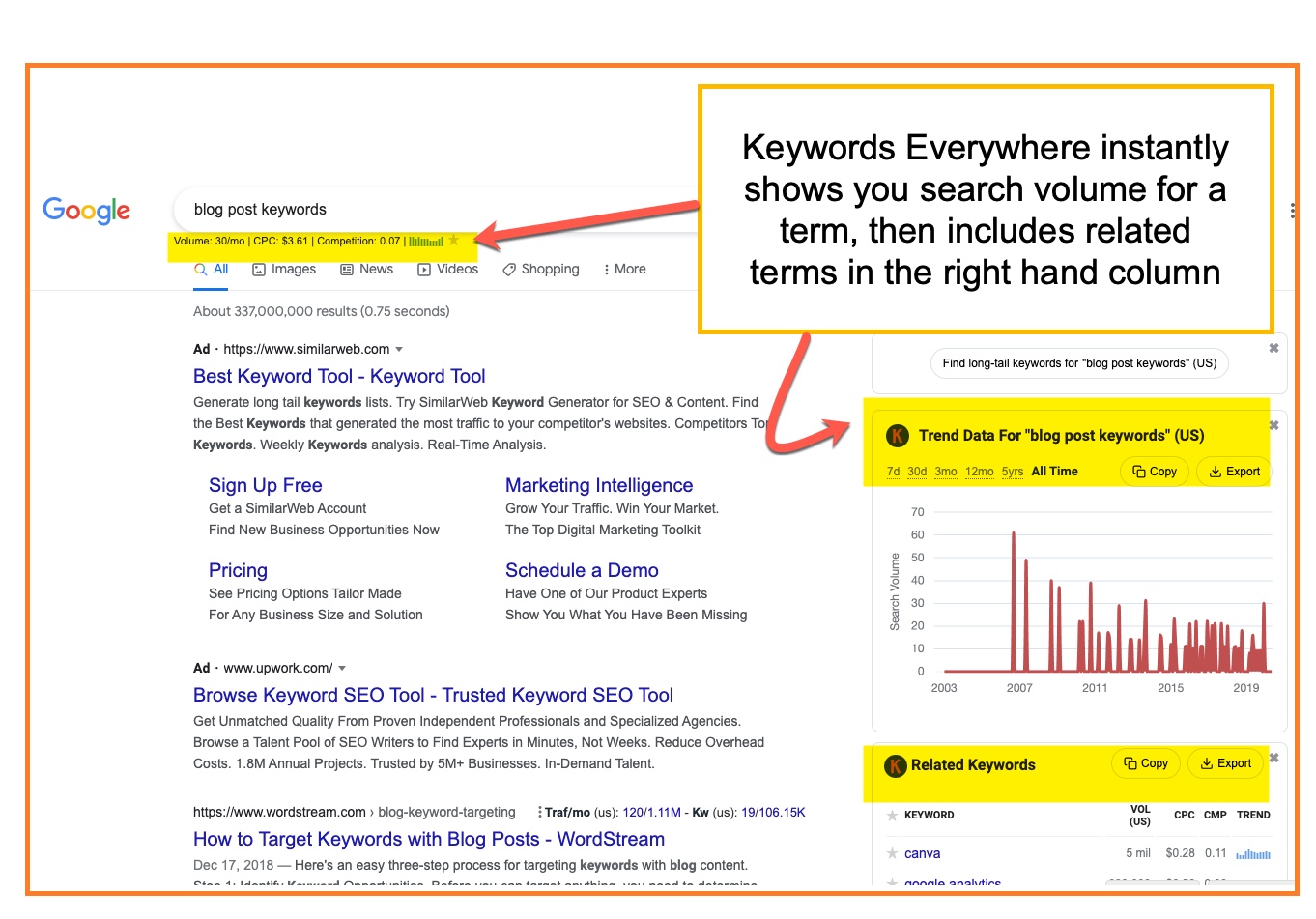
This is only the first step, however. Search volume on Keywords Everywhere is based on Google Adwords traffic, which is their pay-per-click advertising service. It’s advertising. What you really want to see is if there is organic search volume (non-paid) for the term.
Take the term you found and then plug it into a search-engine optimization tool like Semrush. This will tell you organic search volume. (Here’s a short video that shows you how it’s done.)
If there is a relevant keyword, that can help you in the next phase.
☐ Conduct competitive research on your topic
Alright, you’re ready to write on your first topic that you know is important to your customers. Now it’s time to differentiate yourself from the competition.
It’s fairly common for people to write copycat content. They’ll look at what their competition is writing, or they’ll review what comes up on search engines, and take the same approach, assuming since it’s working for someone else, it will work for them.
That’s a recipe for disaster. Google will never rank you above someone who has written the same type of copy, and your customer won’t see a clear difference between you and the rest.
You need to conduct competitive research to see how you can stand out. Here are two methods:
Visit the competition’s website. Search for blog posts they’ve written on similar topics, and think about ways you can produce better content with more insights and useful information.
Search for the topic term on Google, and analyze the top 10 ranking pages. This is the tactic we use, which is based on Tom Gerencer’s incredible book, Think Like Google: Use SEO & Empathy to Rank, Convert and Profit no Matter How Much They Change the Rules.
Tom’s approach focuses on “search intent” for particular phrases. He looks at the results that Google is serving up for an indication of what searchers are really looking for when they type in a keyword. It’s a great way to understand what your customers want.
Key words are just a way to know your reader’s plight.
The results will indicate the type of content that is resonating best with your customers. Does Google return a bunch of “How to” posts when you enter the search term? Or is it a number of “listicles”? (27 Ways to Rank Higher in Google, etc.)
Analyzing the top 10 results will give you empathy for what the searcher is looking for, AND it should naturally help you generate ideas on how to create a blog post that is better than the others.
3. Analyze the different elements of top-ranking posts
Taking a unique approach to the topic is step one. But you should also look at the elements that are currently ranking, or that your competition uses on their own posts, and think about how you can make your post better. That can include:
- More in-depth content
- More images and/or video
- More interviews with outside experts
- More links to research backing up your post
As you’re researching the top-ranking posts of your competitors, write down elements that they’re including, so you know what you should potentially include to make an impact.
Also be aware of the topics they’re NOT including. Hopefully you have some additional insights that can help differentiate you from the competition and showcase your expertise. These should be added to your outline.
☐ Strategize how you can make your post different (and better) than the rest
With your persona in mind and your competitive research completed, now it’s time to think about an approach that’s both unique AND appeals to what your target market wants.
Take this post you’re reading right now for example. It’s written to rank for the keyphrase “blog post checklist.” We picked that because we work with small marketing departments, and many of them are looking for tools to help them assure quality and ensure they’re not missing anything important.
When we Googled the term, we found the top 10 results were all about creating the “ultimate” blog post checklist.

You need to create the differentiator first before you write the post. That’s critical, as it will set the framework for everything that comes next.
PRO TIP: Differentiate yourself from the competition with thought leadership.
If you’re producing true thought leadership content, you’re creating a position that differentiates you from the rest. Research other posts, and make sure you can counter any of their claims with data and a proven approach.
☐ Create an outline for your blog post
Based on how you’re going to differentiate the post, our writers like to write an overall outline so they know what they’ll need to conduct research on in the next phase and what type of experts they’ll need to interview for insights.
When you’re reviewing other blog posts that are ranking, you can pull ideas from what they’ve written, but then also add your own insights into the mix as you create your outline.
Step 2: Find Data and Insights to Include in Your Post
Now that you’ve set your strategy and built an outline, it’s time to find data and proprietary research, as well as expert external and internal insights.
If you’re making a compelling argument, look for data that backs up your claim. This will not only validate your claim, but it shows you’ve done your homework. More importantly, data can improve your results.
In their annual blogger survey, Orbit Media noted statistics and contributor quotes are elements that drive strong results.
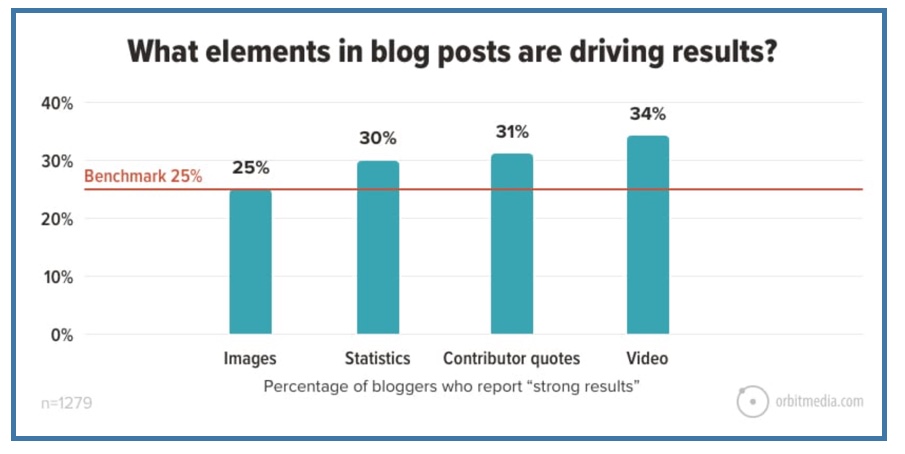
☐ Use statistics from proprietary research
See what we just did above? We snagged some excellent research and used it to enhance our own blog post.
When you start searching for statistics and relevant data, always click through for the original source. That way, not only will you be giving credit where credit is due; you can also tag the company whose research you’ve used when you publicize the post.
(You can bet we’ll be tagging Orbit Media when we publish this post!)
☐ Interview experts for their opinions
Data is great, but there is a lot of credibility to be derived from experts who have been there, done that.
We often reach out to experts for insights and opinions, and then include their quotes in our posts. It’s a great way to gain valuable insights and access their social networks.
See how we quote Cory Warfield below in our post on LinkedIn Company Pages…

…which he then shares on his own social network.
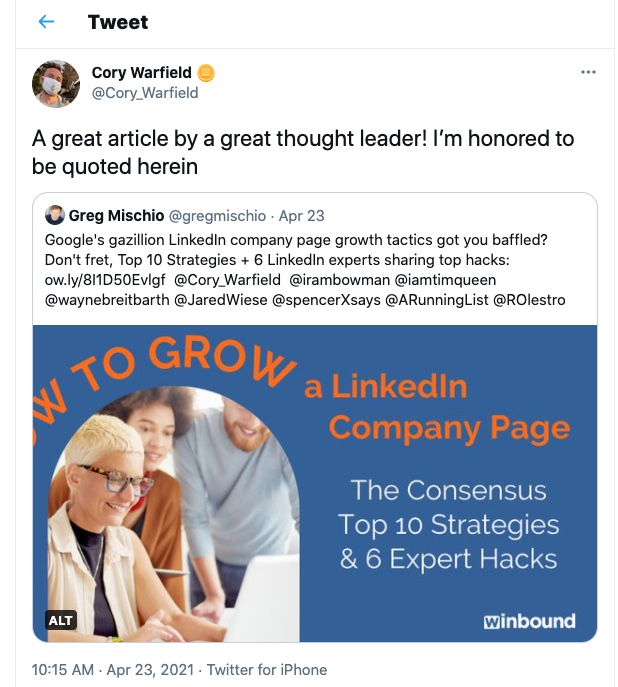
☐ Get quotes from authors and their books
No one has put in more time and thought on a particular topic than book authors. These folks have taken a very deep dive into a topic and often have a ton of research included in their work.
You can gain a significant advantage as a writer by:
1. Reading the book for a deeper understanding of the subject matter (on my soapbox here).
2. Producing quotes and insights from the book. (See what I did near the beginning of the article with the Donald Miller quote?)
Once again, tag the author when you publish the work. The bigger they are, the less likely they will be to acknowledge your quote. But it’s definitely worth an outreach. And I have made contacts and friends with writers I’ve tagged and acknowledged.
☐ Interview internal experts and create multimedia from the interview
Don’t just rely on other experts in the field. Bring your own people into the mix. And bring them to life.
For example, in this post we created for Delta ModTech, we interviewed one of their internal experts, and featured him throughout the post. Then we recorded the interview and featured a short audio excerpt as bonus content. You get to hear the experts’ voices and insights: The real deal!
Step 3. Create a Great Headline
This is perhaps the most underrated part about writing a blog post, but also the most critical. Fairly or unfairly, your headline can make or break your blog post.
To create an ideal one, look back at all the research you’ve done to this point. The type of blog post you’re writing can help you determine the headline you write:
☐ Choose the headline based on the type of post you’re creating
The type of headline you choose will likely depend on the type of post you’re creating. If you’re creating a list of items, you may choose a listicle headline:
7 Ways to Write a Great Headline
If you want to create more of a “How to” post, choose the How To approach.
How to Write Great Headlines
PRO TIP: Use SEO research to choose the right type of headline.
If your goal is for the post to rank for a particular keyword, then the SEO research you conducted earlier should reveal the type of headline you use.
Do search results reveal that listicle posts are doing well? Or are the top results “how to” posts?
Base the type of headline you use for the post on the intent of the search.

A How To post and Listicle, all in one.
If your post is written to stake a claim to some thought leadership, then you’re going to need to be bold and include your point of view in the headline.
For example, if I were writing a headline for a post that embodies the statement directly above, I’d go with “Your Headline is Garbage Unless it Pisses Someone Off.”
☐ Write multiple variations
Writers often put way more time into the body of the article than they do the headline. But why work so hard if no one is there to read it?
Back when I was writing headlines for the outside of envelopes in direct mail campaigns, the goal was to get people to open the envelope because of a great headline. It’s no different for a blog post.
I’d recommend you write 10 headlines for each blog post, at a minimum. The more you write, the more you’ll home in on the ideal message.
☐ Use emotional language
Run-of-the-mill language won’t get you read. Create content that grabs someone and won’t let them go.
The most effective way to do this is to use language that evokes emotion or energy. Here are a number of headline tools that will help you generate emotion-packed headlines, as well as some great headline ideas from writers like Jon Morrow.
CoSchedule’s Online Headline Analyzer
Emotional Headline Analyzer
Jon Morrow’s Headline Hacks
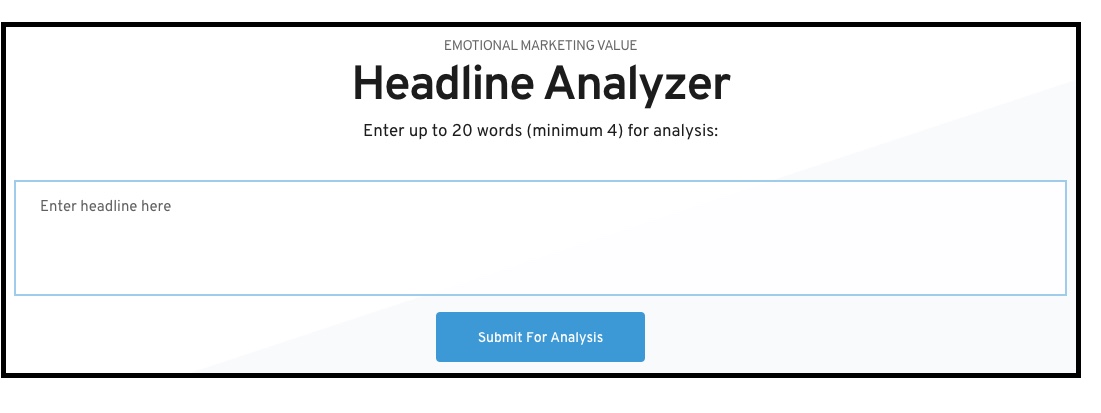
The Advanced Marketing Institute’s headline analyzer assesses emotional words in your headline.
Step 4: Structure Your Content for Skimmers
We’re going to take you through a number of key elements here. Use these as you’re structuring your post.
☐ Get the pain point upfront
BLAM — waste no time. Use neuroscience techniques and speak to the pain point the customer is experiencing upfront.
☐ Share your solution right away
Also in the first few paragraphs, let the customer know how you’re going to take them to the promised land (see the first paragraph of this post).
☐ Create subheadlines (H2, H3, H4) that will tell the story
Think of readers of your blog post as skimmers. They will usually skim through the article to find points that they’re not aware of, and they’ll use your subheads as guides.
We always tell our writers that you should be able to read a post just by the headlines to get the narrative, then your text blocks and graphics share the details.
☐ Keep your paragraphs short
Avoid big walls of text. Keep paragraphs at about 1-3 lines max.
☐ Use bullet points (but follow this format)
Bullet points are great for breaking up text blocks, but we avoid using them for big blocks of text. I’d stick to this guideline:
- Limit yourself to 3-4 bullet points
- Start each bullet with an active verb
- Keep them short and sweet
☐ Use bold subheads for longer blocks of text
We use H1, H2, H3 tags for our outline for skimmers. Sometimes, when you’ve got a lot of items that require more explanation — such as the ones we’re highlighting in this section — we use a bold headline at the front, then go into detail.
☐ Use compelling visuals once every page scroll
People love visuals. Whether you’re using photos, pull quotes or graphics, include visuals throughout your post. The rule of thumb is to have them appear once every page scroll. Here are some visuals that will make you stand out.
☐ Create pull quotes with pictures of people
You can either use the text method (shown above with Cory Warfield’s quote), or the one I created here for Julie Davis of the Association of Equipment Manufacturers. Pictures of people add to the credibility of your content.

☐ Include stats, especially when accompanied by visuals
Check out this visual of LinkedIn users worldwide.

☐ Use Snagit to illustrate otherwise dull pictures
In this photo for Delta ModTech, we used Snagit from TechSmith to explain the components of the machine, so people really know what they’re looking at.

☐ Embed videos
Even if they’re not yours, they’re great for creating dwell time on your post. And to eat my own dog food, here you go:
☐ Use call-to-action buttons
You want someone to take an action based on your blog post — the most popular being to subscribe to a newsletter or to download a piece of content. Make sure a CTA button is at the end of your blog posts and also experiment with pop-up windows for sign-ups.
Step 5: Optimize Your Post
If you’re writing to rank for a post, this part is critical. But you should also use these simple tips for every blog post, as they include critical elements that will appear in SERPs (search engine results pages).
☐ Use keywords correctly
The keyword you’re trying to rank for should appear in your H1 headline and your title tag. Semantic keywords should appear in subheads.
☐ Write the key elements that will appear in your SERPs
These include three important components:
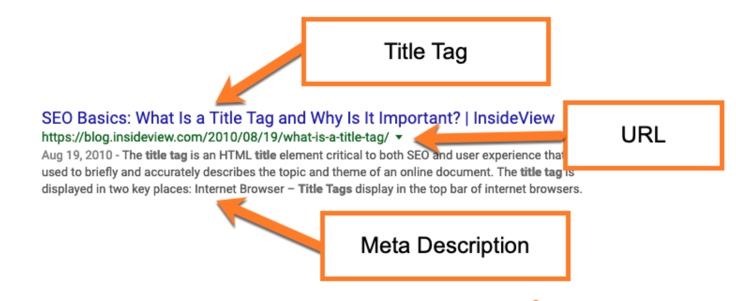
☐ Create a click-worthy title tag
The title tag is what typically appears in the SERP listing, and what shows up in the tabs on your browser. If you want to rank for a keyword, the title tag must be included.
☐ Write a short URL
The shorter, the better. If you can include a keyword, that’s great, but three- to five-word URLs rule. (Ours for this one is /blog-post-checklist.)
☐ Provide a descriptive meta description of what’s in the post
Don’t try and oversell, just include the various elements that will appear in the post. Give a highlight of all the elements you’ll be sharing.
For more on these critical elements, check out our post on how to optimize for SERPs.
PRO TIP: Install the Yoast plug-in if you’re using WordPress. It includes a great interface that allows you to easily create the key elements of the SERP.
Install the Yoast plugin if you’re using WordPress. It includes a great interface that allows you to easily create the key elements of the SERP.
☐ Use H1, H2, H3, etc. headlines correctly
We mentioned earlier that your headlines should tell the story. Make sure you are using the formatting elements on your Content Management System to provide the correct HTML tags to the headers so that search engines will know this is important text.
☐ Link internally
Are you linking to your transaction pages (product and service pages)? You can also link to other high-performing posts. Internal linking helps your overall structure and can pass SEO juice on to other posts.
☐ Write for the Google Answer Box (featured snippet)
Write a section that could be used for the Google Answer Box. Look at some of the other pages on the web and pull together what seems to be the best answer to the question. If you have a list, that’s great too, as Google favors those also. It will pull the list naturally — you don’t have to do anything to make it happen.
Essentially with a Google Answer Box (or featured snippet), you should take one of the following keyword-inspired approaches:
- Create a succinct answer for keywords that ask questions. Any keywords that ask a question (with the exception of how) almost always return a paragraph as an answer. Your paragraph should be in the 40-60 word range.
- Use a list for keywords with propositions. Example: “Types of doors with windows” might be the keyphrase. Make sure the post lists the various types, and you can also answer a potential question in a succinct paragraph at the beginning of the post: “What types of doors include windows?”
- Generate a table for keywords that includes comparisons. Your table could be featured in the Answer Box, particularly when it comes to price comparisons.
This study gives more detail, including golden nuggets like the ones you see below.
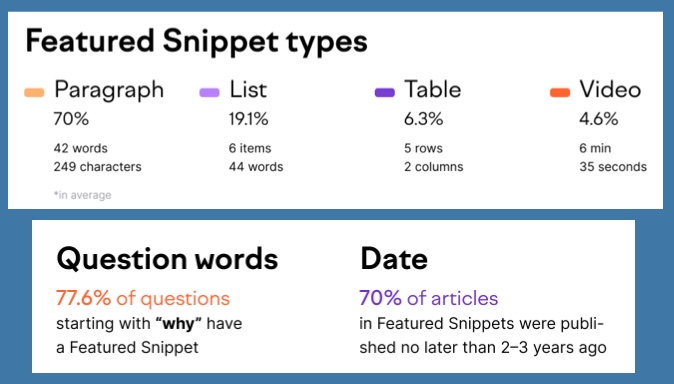
Step 6. Use an Effective Review Process
Now that we’ve touched on the key elements for a blog post, there are a couple simple writing habits you should follow with each post:
☐ Let it sit overnight
I guarantee if you let your draft sit overnight, when you revisit it you’ll find areas for improvement. But don’t let it sit longer than that. As our good friend Spencer X Smith says, “Out the door is better than in the drawer.”
☐ Have someone else proof and read your post
Always recommended. I have other Winbound writers review my posts, and our proofreader finds all the little mistakes. It always makes my blog posts better. Always.
☐ Use collaborative tools for the review process
Choose a tool that allows multiple parties, both inside and outside the organization, to easily collaborate on the content. We really like Google Docs because you can:
- Share a link instead of using attachments
- Refer to “version history” for older comments, keeping your document clean for reviews
- Rely on the cloud-based service to back-up your docs automatically
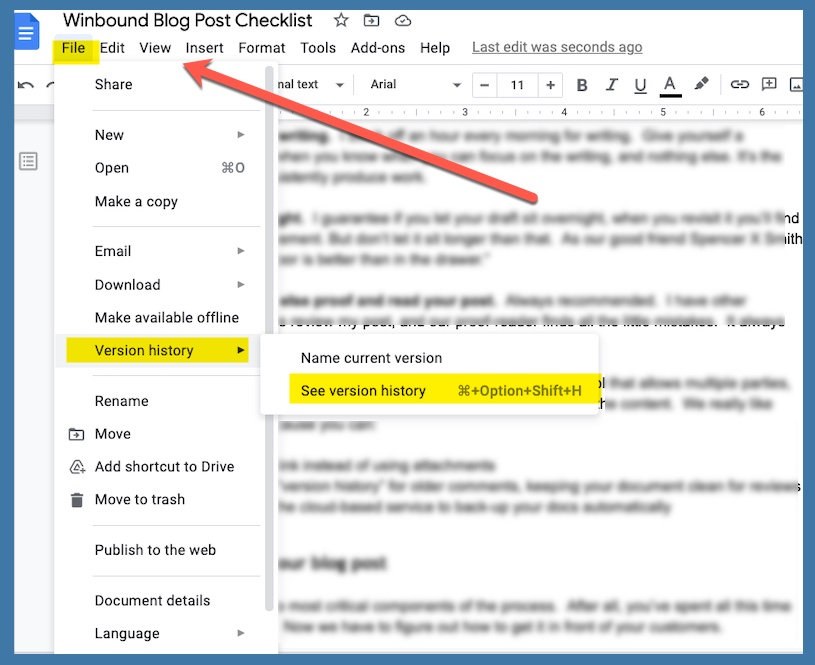
Google Docs version history feature gives you a record of previous changes while keeping your current version clean.
Step 7. Promote Your Blog Post
This is one of the most critical components of the process. After all, you’ve spent all this time writing the post. Now we have to figure out how to get it in front of your customers.
There are numerous strategies and tactics, and you’ll want to create a system specific to each blog post. Here are a number of important tactics we’ve used:
☐ Share through your social media
If you have an online presence that you actively manage, social media is a great way to share content. Don’t just blast it on social media that you rarely use. That’s a waste of time and effort, and you’ll see no results.
☐ Collaborate with other influencers
We mentioned this earlier as a way to improve your content. It’s also a great way to distribute the content, as hopefully they’ll share it with their followers.
☐ Share through your newsletter
If you have a monthly eNewsletter (and you should) include a link to the content.
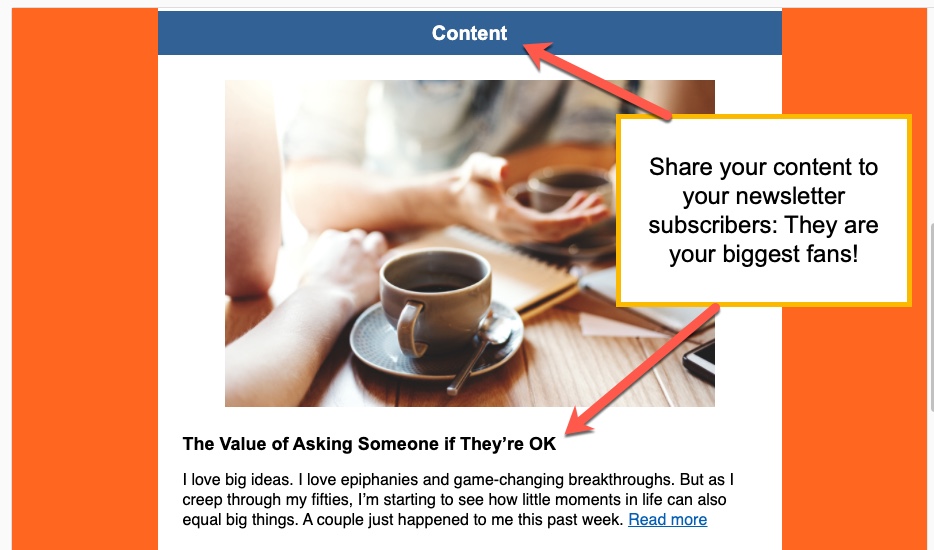
☐ Publish it on free distribution sites
A number of sites will distribute your content for free, such as LinkedIn and Medium. It’s a great source of referral traffic.
☐ Promote it with paid advertising
You can use paid elements to boost the content. This isn’t always recommended if you want to send people back to your website, as social media doesn’t like to have people exit their network.
☐ Repurpose your content
One excellent but underused method is to repurpose and reuse content. For example, take your blog post and make it into a SlideShare document, which you can then upload to LinkedIn. Make a short video out of it. The possibilities are endless.
Step 8. Analyze the Results
Last but certainly not least, you’ll want to track the effectiveness of your blog post. There are two tools we use for this:
☐ Use Google Analytics for key performance metrics
GA offers a wide range of analytic capabilities. The most important success metrics for a blog post are:

- Sessions (how many people are visiting the post)
- Dwell time (average time the visitor spends on the page)
- Conversions (does the post lead to a goal being completed, such as a newsletter sign-up or a form fill)
- Source (where did the traffic come from? — this will tell you if your distribution is working)
☐ Choose an SEO tool to track keywords
This SEO tool allows you to track specific keywords (we use SEMrush), as well as review keywords that the post is ranking for. You can use this data to add more keywords to the post, and more relevant content.
Final Thoughts: Consistency is the Key
The goal of this blog post checklist is to help you create a blog post that will help you beat the competition and reach your marketing goals. It’s also a quality control mechanism that will help you consistently focus on the vital elements for success.
As Keith Cunningham wrote, “Ordinary things done consistently produce extraordinary results.”



